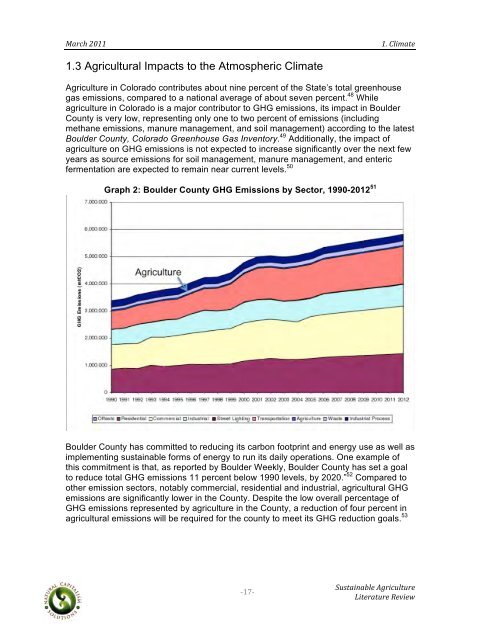Sustainable Agriculture Literature Review - Boulder County
Sustainable Agriculture Literature Review - Boulder County
Sustainable Agriculture Literature Review - Boulder County
Create successful ePaper yourself
Turn your PDF publications into a flip-book with our unique Google optimized e-Paper software.
! ! !!<br />
"#$%&!'())! !!!!!!!!!!!!!!!!!!!!!!!!!!!!!!!!!!!!!!!!!!!!!!!!!! )=!>1.;#-2!<br />
1.3 Agricultural Impacts to the Atmospheric Climate<br />
<strong>Agriculture</strong> in Colorado contributes about nine percent of the State’s total greenhouse<br />
gas emissions, compared to a national average of about seven percent. 48 While<br />
agriculture in Colorado is a major contributor to GHG emissions, its impact in <strong>Boulder</strong><br />
<strong>County</strong> is very low, representing only one to two percent of emissions (including<br />
methane emissions, manure management, and soil management) according to the latest<br />
<strong>Boulder</strong> <strong>County</strong>, Colorado Greenhouse Gas Inventory. 49 Additionally, the impact of<br />
agriculture on GHG emissions is not expected to increase significantly over the next few<br />
years as source emissions for soil management, manure management, and enteric<br />
fermentation are expected to remain near current levels. 50<br />
!<br />
Graph 2: <strong>Boulder</strong> <strong>County</strong> GHG Emissions by Sector, 1990-2012 51<br />
<strong>Boulder</strong> <strong>County</strong> has committed to reducing its carbon footprint and energy use as well as<br />
implementing sustainable forms of energy to run its daily operations. One example of<br />
this commitment is that, as reported by <strong>Boulder</strong> Weekly, <strong>Boulder</strong> <strong>County</strong> has set a goal<br />
to reduce total GHG emissions 11 percent below 1990 levels, by 2020.” 52 Compared to<br />
other emission sectors, notably commercial, residential and industrial, agricultural GHG<br />
emissions are significantly lower in the <strong>County</strong>. Despite the low overall percentage of<br />
GHG emissions represented by agriculture in the <strong>County</strong>, a reduction of four percent in<br />
agricultural emissions will be required for the county to meet its GHG reduction goals. 53<br />
"+("<br />
!*+,-#./#012!34$.%+1-+$2!<br />
5.-2$#-+$2!627.28!
















